This is how Spain celebrates Halloween (a festival invented in Galicia)

The Halloween holiday is celebrated across Spain not least because it involves a national bank holiday tagged onto a weekend which is known as a puente and ensures that everyone has three days off.
But of course this is Spain which means that things are done their own way, so don’t expect carved pumpkins and trick or treating to done in the same way as it is in America.
Three, four or even five day celebration
Friday is a bank holiday across all of Spain to mark All Saints Day.
Some regions of Spain (Madrid, Galicia) close the schools on Thursday October 31st and in Galicia it is also a day off on Monday November 3rd.
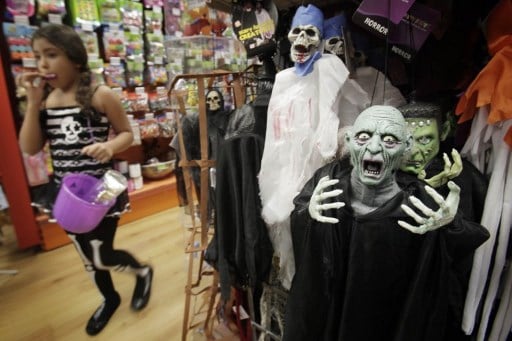 Photo: AFP
Photo: AFP
Dressing up
Children are expected to dress up in spooky costumes for their last day of school before the Halloween long weekend, oh and the teachers too, and things generally focus on the creepy. Think witches, zombies and devils rather than superheroes, TV stars and literary favourites.
Some towns stage community trick or treating events inviting children in dress-up to visit a circuit of shops where they will be given candy and treats culminating in a costume party in a local square.
At night pubs, clubs and restaurants will be staging Halloween themed events – there’s no work the next day remember so it’s an excuse to party.
You might also come across an organised zombie march taking place in a plaza near you.
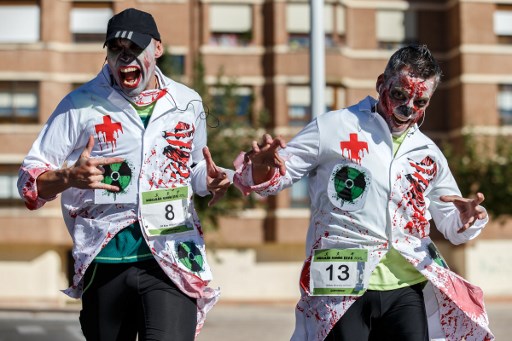
Photo: AFP
READ ALSO:
-
Spain's Halloween puente: Warmer than usual but take an umbrella
-
Ten very creepy Halloween costume ideas from Spain
-
IN PICS: This is how All Saints' Day is celebrated in Madrid
Galicia: The birthplace of Halloween
In Galicia, the northwestern region famous for its rich Gaelic folklore and ghost legends, Halloween is a seriously big deal. In fact, some argue that it was invented here.
Known as Samaín the ancient autumn festival celebrated in Galicia was a precursor of America's Halloween.
In Galician villages such as Cedeira, O Vicedo and Narón, kids and adults have for centuries dressed up as spirits and magical beings, organised death marches, carved scary faces in pumpkins and gone trick or treating.
It starts on October 31st with the Noite dos Calacús (Night of the Pumpkins) involving as pumpkin carving, costume parties, bonfires, rituals.
Look out for the queimada – a hot punch made from orujo mixed with herbs, sugar, lemon peel, apple and coffee beans. It is brewed in a special clay pot and stirred with a ladle while incantations banishing evil are chanted over it as it burns with a blue flame.
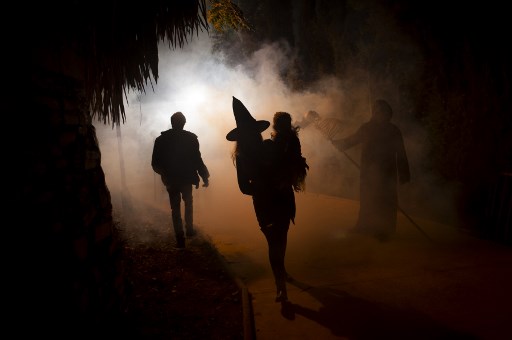 Photo: AFP
Photo: AFP
Catalonia, chestnuts and witches
Across Catalonia, towns stage the traditional Castanyada – the traditions of which date back hundreds of years and involve a funereal feast of vegetables, nuts, chestnuts and small bread rolls known as panallets.
READ ALSO: Panellets: How to make the traditional Catalan Halloween treat
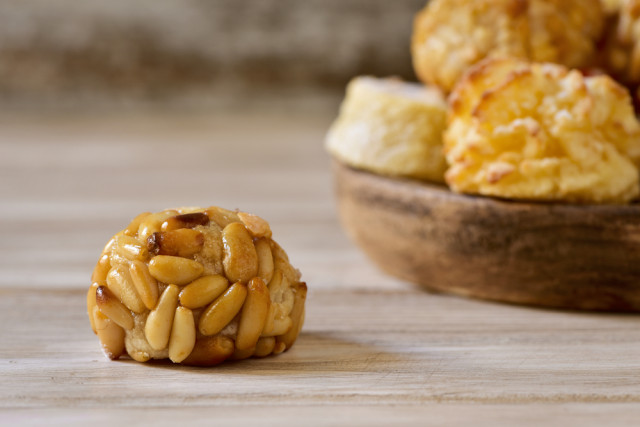 Photo: nito103/Depositphotos
Photo: nito103/Depositphotos
Halloween is also known in Spain as Dia de las Brujas and you’ll see creepy decorations of witches propped up all over the place.
The small town of Sant Feliu Sasserra near Bages in Catalonia really celebrates the witch cult honouring 23 women sentenced to death for witchcraft during the Inquisition.
All Saints Day
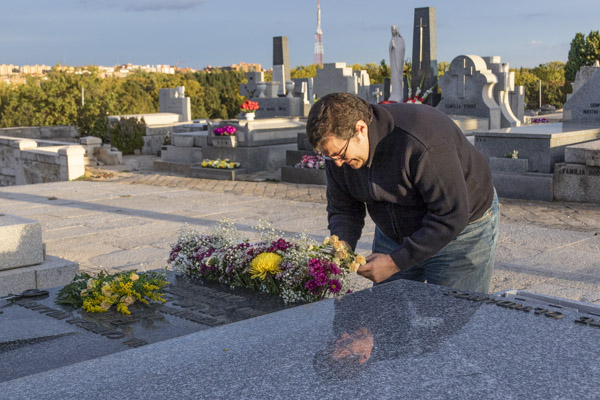
A man tends the grave of a loved on in Almudena cemetery in Madrid. Photo: Lynn Spreadbury/The Local
November 1st is the Día de Todos los Santos when families gather in cemeteries to tend to their loved ones’ graves taking fresh flowers and special pastries.
These include the peculiarly named buñuelos de viento – nun’s farts – which are bite-sized donuts filled wih cream; huesos de santo - bones of the holy - which are finger sized tubes of marzipan; and panellets, nutty pasties.
HolyWin
It’s not all about ghouls and ghosties.
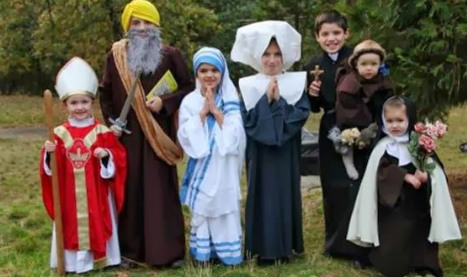
Suggested outfits from the Bishopric of Cadiz and Ceuta. Photo: Shower of Roses
The Spanish Catholic Church has been fighting back against the popularity of the "satanic festival" of Halloween by urging good Christian children to forgo zombie, ghost and devil outfits and instead dress up as "saints, virgins and apostles".
You may come across one of the "Holywins" parties thrown by churches or catholic schools with children dressing up their favourite saint, a monk or nun, or even one of the apostles.
"With Holywins, which stands for Holiness Wins, one can avoid the pagan festival and reclaim the meaning of the Catholic feast day of All Saints," reads a statement from the Diocese of Cartagena.
READ MORE: 12 Spanish horror films to terrify you at Halloween
Comments
See Also
But of course this is Spain which means that things are done their own way, so don’t expect carved pumpkins and trick or treating to done in the same way as it is in America.
Three, four or even five day celebration
Friday is a bank holiday across all of Spain to mark All Saints Day.
Some regions of Spain (Madrid, Galicia) close the schools on Thursday October 31st and in Galicia it is also a day off on Monday November 3rd.
 Photo: AFP
Photo: AFP
Dressing up
Children are expected to dress up in spooky costumes for their last day of school before the Halloween long weekend, oh and the teachers too, and things generally focus on the creepy. Think witches, zombies and devils rather than superheroes, TV stars and literary favourites.
Some towns stage community trick or treating events inviting children in dress-up to visit a circuit of shops where they will be given candy and treats culminating in a costume party in a local square.
At night pubs, clubs and restaurants will be staging Halloween themed events – there’s no work the next day remember so it’s an excuse to party.
You might also come across an organised zombie march taking place in a plaza near you.

Photo: AFP
READ ALSO:
- Spain's Halloween puente: Warmer than usual but take an umbrella
- Ten very creepy Halloween costume ideas from Spain
- IN PICS: This is how All Saints' Day is celebrated in Madrid
Galicia: The birthplace of Halloween
In Galicia, the northwestern region famous for its rich Gaelic folklore and ghost legends, Halloween is a seriously big deal. In fact, some argue that it was invented here.
Known as Samaín the ancient autumn festival celebrated in Galicia was a precursor of America's Halloween.
In Galician villages such as Cedeira, O Vicedo and Narón, kids and adults have for centuries dressed up as spirits and magical beings, organised death marches, carved scary faces in pumpkins and gone trick or treating.
It starts on October 31st with the Noite dos Calacús (Night of the Pumpkins) involving as pumpkin carving, costume parties, bonfires, rituals.
Look out for the queimada – a hot punch made from orujo mixed with herbs, sugar, lemon peel, apple and coffee beans. It is brewed in a special clay pot and stirred with a ladle while incantations banishing evil are chanted over it as it burns with a blue flame.
 Photo: AFP
Photo: AFP
Catalonia, chestnuts and witches
Across Catalonia, towns stage the traditional Castanyada – the traditions of which date back hundreds of years and involve a funereal feast of vegetables, nuts, chestnuts and small bread rolls known as panallets.
READ ALSO: Panellets: How to make the traditional Catalan Halloween treat
 Photo: nito103/Depositphotos
Photo: nito103/Depositphotos
Halloween is also known in Spain as Dia de las Brujas and you’ll see creepy decorations of witches propped up all over the place.
The small town of Sant Feliu Sasserra near Bages in Catalonia really celebrates the witch cult honouring 23 women sentenced to death for witchcraft during the Inquisition.
All Saints Day

A man tends the grave of a loved on in Almudena cemetery in Madrid. Photo: Lynn Spreadbury/The Local
November 1st is the Día de Todos los Santos when families gather in cemeteries to tend to their loved ones’ graves taking fresh flowers and special pastries.
These include the peculiarly named buñuelos de viento – nun’s farts – which are bite-sized donuts filled wih cream; huesos de santo - bones of the holy - which are finger sized tubes of marzipan; and panellets, nutty pasties.
HolyWin
It’s not all about ghouls and ghosties.

Suggested outfits from the Bishopric of Cadiz and Ceuta. Photo: Shower of Roses
The Spanish Catholic Church has been fighting back against the popularity of the "satanic festival" of Halloween by urging good Christian children to forgo zombie, ghost and devil outfits and instead dress up as "saints, virgins and apostles".
You may come across one of the "Holywins" parties thrown by churches or catholic schools with children dressing up their favourite saint, a monk or nun, or even one of the apostles.
"With Holywins, which stands for Holiness Wins, one can avoid the pagan festival and reclaim the meaning of the Catholic feast day of All Saints," reads a statement from the Diocese of Cartagena.
READ MORE: 12 Spanish horror films to terrify you at Halloween
Join the conversation in our comments section below. Share your own views and experience and if you have a question or suggestion for our journalists then email us at [email protected].
Please keep comments civil, constructive and on topic – and make sure to read our terms of use before getting involved.
Please log in here to leave a comment.